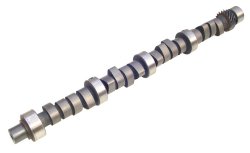| Camshaft
Synchronises valve timing to control Negative
Supercharging process and enhance supercharging effect
 |
Stage 1- 6 uses
the same flat-tappet cam
Negative Supercharging flat-tappet cam features:
- Unique valve timing events that work together in
synch to control the negative supercharging process
and enhance the supercharging effect
- High lift intake profiles that allow more air to
be pulled into the engine by the substantially reduced
pressure in the cylinder
- Early closing intake profiles that trap the larger
volume of air in the cylinder
- Low lift early closing exhaust profiles that allow
the negative pressure in the header to pull the intake
charge into the cylinder instead of into the exhaust
system
|
Stage 7 uses roller cam
Due to the high cost of roller cams, Stage 7 only comes with
a roller cam and lifters. The Negative Supercharging roller
cam features the same valve timing events, synchronised valve
timing and low exhaust lift as the Negative Supercharging flat-tappet
cam but with much higher intake lift. Therefore, the roller
cam may be used with Stage 1-6, but the higher intake lift of
the roller cam requires .080" more piston to valve clearance.
Negative Supercharging flat-tappet
or roller cam MUST be installed in a critical position
The Negative Supercharging camshaft can NOT be advanced or retarded
to optimise performance like conventional cams.
For example,
- If the cam is advanced or retarded by more than 2° and
no more than 6° from the optimum installed position, the
engine will progressively lose more power the more the cam
is advanced or retarded.
- If the cam is advanced by more than 6° from the optimum
installed position, the engine will lose even more power.
- If the cam is retarded by more than 6° from the optimum
installed position, the engine will lose all power.
| Impulse Engine Technology
P/L |
PO Box 986 Randwick NSW 2031 Australia
Ph: (02) 9398 5544
Fax: (02) 9398 5644
International: Ph: +(612) 9398 5544
Fax: +(612) 9398 5644
Email Us
Inventor of Negative Pressure Supercharging
|
|


